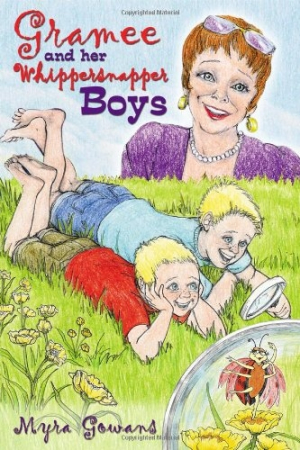Gramee and Her Whippersnapper Boys
The relationship between a grandmother and her grandsons can be a special one, whatever form it may take. There’s the “primary caretaker/setting the rules” grandmother, the “non-primary/bending the rules” grandmother, and then there’s the grandmother who opens new windows of perspective for children simply by sharing her own. This latter description fits the character Gramee in Myra Gowans’ new book, Gramee and Her Whippersnapper Boys.
Gowans originally wrote the book for her grandsons, but she was soon encouraged to make it available to the public as well. It is now the first in a planned series of “Whippersnapper Boys” books.
In the story, Gramee visits her two grandsons, Campbell and Liam, on a beautiful sunny day, and they discover a ladybug in the grass. Gramee comments that LaLa Ladybug considers herself Queen of the Lawn, and her grandsons want to know why. Gramee is soon prompted to tell a “Whippersnapper” story of her own childhood. It’s a short, simple, enjoyable tale, and might bring about that moment of wonder in children when they realize that life (in all its forms) pre-dated their own births.
Gowans writes in a melodic, highly alliterative rhyming style that many children will love. She also uses repetition in a mostly effective way. For example, the magnifying glass that Gramee uses with the boys is never just a magnifying glass—it is a “magnificent, mystical, magical, magnifying glass,” or alternatively, a “magical, marvelous, magnifying glass,” or, a “magical, mystical magnifying glass.”
The sing-song nature of the text should appeal to those in the under-ten set, but adults might find their patience tested after reading some of the descriptions several times. The following passage might be a good litmus test: “Campbell and Liam peered through their exotic, magical, magnifying glass and they surely and truly did see LaLa Ladybug fluffing and flipping and fluttering and flapping her itsy-bitsy, teeny-tiny, eenie-weenie LaLa Ladybug wings.”
The colored-pencil illustrations are well done, but human characters are drawn in a realistic style that may not have been the best choice for a book seeking a wide audience. On some pages, the realism proves distracting, as characters look directly at the reader, as if meant to invoke a “Hey look! We’re in a book!” response from the author’s original intended audience, her own family. The insect characters, on the other hand, are rendered in a more cartoon-like style that works nicely throughout the story.
Overall, Gramee and Her Whippersnapper Boys is a simple, charming tale where the most important element is not the story or the art, but the love and joy in being together that clearly radiates from the characters. It would make a memorable gift from a grandmother to grandsons, but might also prove a fun read for any child with a taste for the whimsical.
Reviewed by
Peter Dabbene
Disclosure: This article is not an endorsement, but a review. The publisher of this book provided free copies of the book and paid a small fee to have their book reviewed by a professional reviewer. Foreword Reviews and Clarion Reviews make no guarantee that the publisher will receive a positive review. Foreword Magazine, Inc. is disclosing this in accordance with the Federal Trade Commission’s 16 CFR, Part 255.

